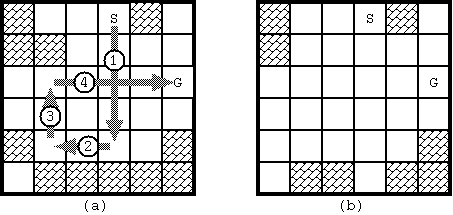| Time Limit: 1000MS | Memory Limit: 65536K | |
| Total Submissions: 10859 | Accepted: 4586 |
Description
On Planet MM-21, after their Olympic games this year, curling is getting popular. But the rules are somewhat different from ours. The game is played on an ice game board on which a square mesh is marked. They use only a single stone. The purpose of the game is to lead the stone from the start to the goal with the minimum number of moves.
Fig. 1 shows an example of a game board. Some squares may be occupied with blocks. There are two special squares namely the start and the goal, which are not occupied with blocks. (These two squares are distinct.) Once the stone begins to move, it will proceed until it hits a block. In order to bring the stone to the goal, you may have to stop the stone by hitting it against a block, and throw again.

Fig. 1: Example of board (S: start, G: goal)
The movement of the stone obeys the following rules:

Fig. 2: Stone movements
Under the rules, we would like to know whether the stone at the start can reach the goal and, if yes, the minimum number of moves required.
With the initial configuration shown in Fig. 1, 4 moves are required to bring the stone from the start to the goal. The route is shown in Fig. 3(a). Notice when the stone reaches the goal, the board configuration has changed as in Fig. 3(b).

Fig. 3: The solution for Fig. D-1 and the final board configuration
Input
The input is a sequence of datasets. The end of the input is indicated by a line containing two zeros separated by a space. The number of datasets never exceeds 100.
Each dataset is formatted as follows.
the width(=w) and the height(=h) of the board
First row of the board
...
h-th row of the board
The width and the height of the board satisfy: 2 <= w <= 20, 1 <= h <= 20.
Each line consists of w decimal numbers delimited by a space. The number describes the status of the corresponding square.
0 vacant square 1 block 2 start position 3 goal position
The dataset for Fig. D-1 is as follows:
6 6
1 0 0 2 1 0
1 1 0 0 0 0
0 0 0 0 0 3
0 0 0 0 0 0
1 0 0 0 0 1
0 1 1 1 1 1
Output
For each dataset, print a line having a decimal integer indicating the minimum number of moves along a route from the start to the goal. If there are no such routes, print -1 instead. Each line should not have any character other than this number.
Sample Input
2 1 3 2 6 6 1 0 0 2 1 0 1 1 0 0 0 0 0 0 0 0 0 3 0 0 0 0 0 0 1 0 0 0 0 1 0 1 1 1 1 1 6 1 1 1 2 1 1 3 6 1 1 0 2 1 1 3 12 1 2 0 1 1 1 1 1 1 1 1 1 3 13 1 2 0 1 1 1 1 1 1 1 1 1 1 3 0 0
Sample Output
1 4 -1 4 10 -1
题意:冰壶每次能够往一个方向运动,且只有越到障碍物和到达中点才会停止,当遇到障碍物时,会把障碍物撞碎,并停留在撞碎前的位置,即冰壶不会替代障碍物位置,同时冰壶需要运动空间,不能挨着撞碎障碍物,当然紧挨终点无所谓,题意要求在十次及以内到达终点。
首先想到了BFS,但后来想想在过程中地图会改变,可知BFS显然不适合这题,由于题意只需求十次的运动,用DFS加上点剪枝也能轻松完成!!!!
AC代码如下:
#include<iostream>
#define inf 100000000
using namespace std;
int n,m,minn;
int map[25][25],vis[25][25];
int si,sj,ei,ej;
void dfs(int h,int z,int cur)
{
int i,j;
if(cur==11)//步数剪枝
return ;
for(i=h+1;i<n;i++)//这里我采用了枚举出四个方向
{
if(map[i][z]==3)
{
if(cur<minn)
minn=cur;
return;
}
if(map[i][z]==1)
{
if(i==h+1) break;//紧挨剪枝
map[i][z]=0;
dfs(i-1,z,cur+1);
map[i][z]=1;
break;
}
}
for(i=h-1;i>=0;i--)
{
if(map[i][z]==3)
{
if(cur<minn)
minn=cur;
return;
}
if(map[i][z]==1)
{
if(i==h-1) break;
map[i][z]=0;
dfs(i+1,z,cur+1);
map[i][z]=1;
break;
}
}
for(i=z+1;i<m;i++)
{
if(map[h][i]==3)
{
if(cur<minn)
minn=cur;
return;
}
if(map[h][i]==1)
{
if(i==z+1) break;
map[h][i]=0;
dfs(h,i-1,cur+1);
map[h][i]=1;
break;
}
}
for(i=z-1;i>=0;i--)
{
if(map[h][i]==3)
{
if(cur<minn)
minn=cur;
return;
}
if(map[h][i]==1)
{
if(i==z-1) break;
map[h][i]=0;
dfs(h,i+1,cur+1);
map[h][i]=1;
break;
}
}
}
int main()
{
int i,j;
while(cin>>m>>n,n||m)
{
for(i=0;i<n;i++)
for(j=0;j<m;j++)
{
cin>>map[i][j];
if(map[i][j]==2)
{si=i;sj=j;}
if(map[i][j]==3)
{ei=i;ej=j;}
}
minn=inf;
//cout<<si<<" "<<sj<<endl;
dfs(si,sj,1);
if(minn==inf||minn>10)
cout<<"-1"<<endl;
else
cout<<minn<<endl;
}
return 0;
}
POJ 3009 Curling 2.0,布布扣,bubuko.com
原文地址:http://blog.csdn.net/hanhai768/article/details/37689345